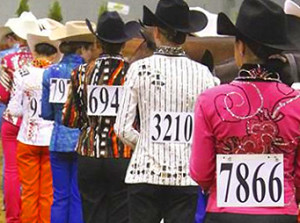Showmanship – The Next Level of Ground Work
Click here to read the complete article254 – October, 2017
by Richard Shrake
 Why showmanship is the advanced level beyond the round pen and longing.
Why showmanship is the advanced level beyond the round pen and longing.
In this article I would like to explain the reasons why showmanship is the next level of ground work when training your horse, compared to round penning or longing.
With over 40 years’ experience in the horse world as a professional horseman, I have had the privilege and pleasure to have used all three methods of ground work as a trainer and coach when operating a public stable for over 30 years. I was also fortunate to have written and published several educational articles on all three methods plus conducting demonstrations at equine expos around the globe. This being said, I feel it has all been time tested by thousands of horse owners. I have always personally felt you need to “crack the egg before you can cook the omelet.” That’s why I am still coaching and teaching at 73. Please do not think I am being overworked; quite frankly, it has been an easy job. About as easy as teaching a mosquito to hum.
Early in the 1960s and ‘70s, the round pen was at its height of popularity. Actually, it goes back over a couple hundred years ago. The round pen was a very confined and inexpensive way for a horseman to train and bond with a horse, gaining mental and physical obedience before they got on its back. They did not need to use ropes or hobbles but rather gave the horse total freedom to go forward. This would allow the trainer to advance and retreat giving the horse the free will to go into their natural instinct of flight without being trapped or cornered. This resistance-free method was also a big plus, giving each horse his own self-carriage and a way to develop his own maximum balance. This was especially true when the trainer was able to control the horse’s space by changing the speed and changing their space. This enabled the horse to collect and extend most of their gaits, again before they were even ridden.
For example, one of my early mentors as a young trainer was the legendary Chief Rojas from California. He would always have me focus on the shadow of a horse in the round pen, especially when reversing and doing rollbacks. He would say, “Watch the feel and shape of the horse’s body during the maneuver.” I remember I always thought it was cool to see how and why the horse would slow down and speed up when done in the shadow and the mirrorlike movement. For whatever reason, it was a light bulb moment at that time in my career when it came to developing mental and physical obedience in my horses.
Click here to read the complete article254 – October, 2017










